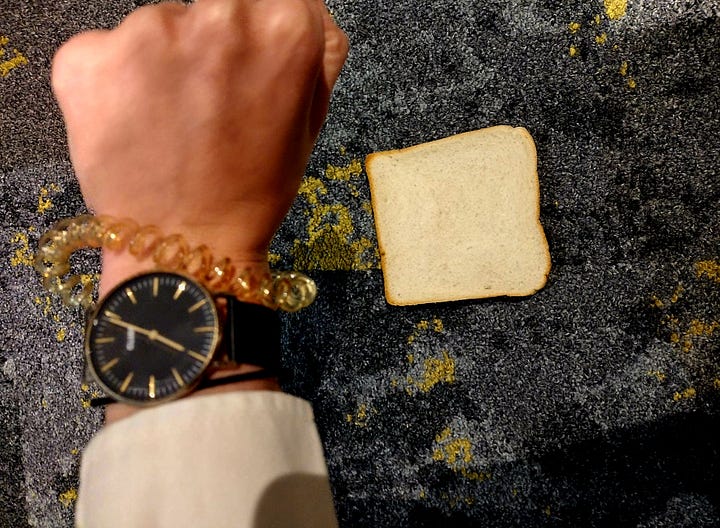Picture this. You’re standing on one side of the planet, let’s say on a smallish island in the Northern Hemisphere, and you have a slice of bread. Then there’s somebody on the opposite side of the planet, a city in Australia for example, and they have a similar slice of bread. Then you place your bread on the ground and they place their bread on the ground. What you’re doing there is making an Earth sandwich.
Did we dare to dream? We did, making hay (and a sandwich) while the sun shone (in Australia). We asked our unfazed pals who were roaming the opposite ends of the Earth to pick up a standard loaf of sliced white, run the numbers on timezones and schedule the snack. The ten hour difference meant that tea and breakfast were both catered for: 7pm in Australia and 9am here. I was walking to work when it happened (our North Hem man on the ground – whose whole audacious brainchild this was, and yes, I am legally bound to him – had it covered) but I’m sure I felt a delicious shift in the tectonic plates as they were briefly sandwiched. Or perhaps it was the sensation of a long-floated and oft discussed idea finally being realised so we could tick it off the whimsy list. All this led to meal deal chat, as things inevitably do. If the Earth sandwich was your main, what would your snack and drink be? A packet of Space Raiders and a bottle of Mars chocolate milk of course. Or a Milky Way and a Capri-Sun at a push.


Incidentally, on the very same day the Earth was a sandwich I was given a free loaf of sourdough. A friend and I were drinking Pet Nat at a local bottle shop/bar/cafe that evening (painfully @real_housewives_of_clapton. Don’t mind it). We were the last two to leave and the chap had two loaves he reluctantly couldn’t sell the next day, so we went on our way cradling crusty spoils. I ate the loaf over the best part of a week, and of course it was still stellar. Don’t get me wrong, I ate the sliced white too, appreciating how it’s both velvet and polystyrene, and how it can turn to putty or glue. Each square elevated by a zig-zag of sriracha. This bread puts paid to the validity of the salivary amylase test, the one were you chew bread for an overlong time until it tastes sweet. But summer puddings certainly enjoy the fruit of its labour.
Around this time I was reading a novel in which a meal deal is given due attention. (A friend was also reading the book and sent a photo of the para, so I was keen to get to this plot point.) A British character lives in Paris and the thing he misses most is a meal deal. Hugely plausible. But I do slightly question the example quoted (though a Coke vs Pepsi debate always rings true, despite the clear winner). I know the novel is set a few years ago, and cost of living has taken its cruel toll on inclusions and price points, but I’m just not convinced there was a ham hock option at Tesco, the supermarket referenced in the text. However, I should do my research before I mouth off.
Speaking of fun! research! I recommend the Cursed Objects podcast, specifically the episode all about meal deals. Not least because the guest reminded me of this excellent Guardian long read by Sam Knight on the packaged sandwich industry. In the pod they recall nuggets from it, like the name of the specially engineered sandwich packet: skillet. And the air pockets within the curves of iceberg lettuce leaves: goblin caves. The whole article is brimming with riches. I urge you to read it in full (interesting to do so now as it was written in 2017, just post-Brexit vote, and also mentions the inferred anomaly of a ‘dramatic change in our circumstances’ caused by the 2008 financial crash . . .) but I’ve pulled out just three examples of top tier reportage that delighted me.
Whiteside immersed himself in questions of “carriers” (bread), “barriers” (butter, mayonnaise), “inclusions” (things within the bread), “proteins” (tuna, chicken, bacon) until they bordered on the philosophical. “What is more important, the carrier or the filling?” he wondered.
People in the industry talk about seminal new combinations – Pret’s crayfish and rocket; M&S’s Wensleydale and carrot chutney – like Peter Brook’s Midsummer Night Dream, or Zeffirelli’s Romeo and Juliet. The story comes alive again.
A person known as the “stacker” then put two sandwiches on top of each other and fed them into the Grote AC60 ultrasonic cutting machine. Chahar and I drew close. A tiny whine emanated from the titanium blade, which was vibrating 20,000 times a second and making perfect triangles. Ultrasonic cutters were designed to slice faultlessly through chocolate and cheese. “It can cut through,” murmured Chahar. “You will not feel the pain. Trust me.”




